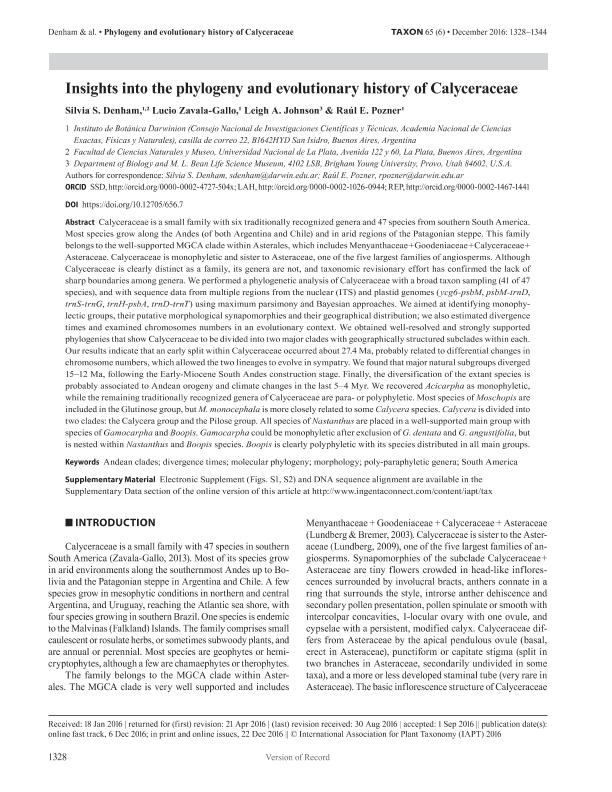Artículo
Insights into the phylogeny and evolutionary history of Calyceraceae
Fecha de publicación:
12/2016
Editorial:
International Association for Plant Taxonomy
Revista:
Taxon
ISSN:
0040-0262
Idioma:
Inglés
Tipo de recurso:
Artículo publicado
Clasificación temática:
Resumen
Calyceraceae is a small family with six traditionally recognized genera and 47 species from southern South America. Most species grow along the Andes (of both Argentina and Chile) and in arid regions of the Patagonian steppe. This family belongs to the well-supported MGCA clade within Asterales, which includes Menyanthaceae + Goodeniaceae + Calyceraceae + Asteraceae. Calyceraceae is monophyletic and sister to Asteraceae, one of the five largest families of angiosperms. Although Calyceraceae is clearly distinct as a family, its genera are not, and taxonomic revisionary effort has confirmed the lack of sharp boundaries among genera. We performed a phylogenetic analysis of Calyceraceae with a broad taxon sampling (41 of 47 species), and with sequence data from multiple regions from the nuclear (ITS) and plastid genomes (ycg6-psbM, psbM-trnD,trnS-trnG, trnH-psbA, trnD-trnT) using maximum parsimony and Bayesian approaches. We aimed at identifying monophylectic groups, their putative morphological synapomorphies and their geographical distribution; we also estimated divergence times and examined chromosomes numbers in an evolutionary context. We obtained well-resolved and strongly supported phylogenies that show Calyceraceae to be divided into two major clades with geographically structured subclades within each. Our results indicate that an early split within Calyceraceae occurred about 27.4 Ma, probably related to differential changes in chromosome numbers, which allowed the two lineages to evolve in sympatry. We found that major natural subgroups diverged 15?12 Ma, following the Early-Miocene South Andes construction stage. Finally, the diversification of the extant species is probably associated to Andean orogeny and climate changes in the last 5?4 Myr. We recovered Acicarpha as monophyletic, while the remaining traditionally recognized genera of Calyceraceae are para- or polyphyletic. Most species of Moschopis are included in the Glutinose group, but M. monocephala is more closely related to some Calycera species. Calycera is divided into two clades: the Calycera group and the Pilose group. All species of Nastanthus are placed in a well-supported main group with species of Gamocarpha and Boopis. Gamocarpha could be monophyletic after exclusion of G. dentata and G. angustifolia, but is nested within Nastanthus and Boopis species. Boopis is clearly polyphyletic with its species distributed in all main groups.
Archivos asociados
Licencia
Identificadores
Colecciones
Articulos(IBODA)
Articulos de INST.DE BOTANICA DARWINION (I)
Articulos de INST.DE BOTANICA DARWINION (I)
Citación
Denham, Silvia Suyai; Zavala Gallo, Lucio Martín; Johnson, LeighA.; Pozner, Raúl Ernesto; Insights into the phylogeny and evolutionary history of Calyceraceae; International Association for Plant Taxonomy; Taxon; 65; 6; 12-2016; 1328-1344
Compartir
Altmétricas




